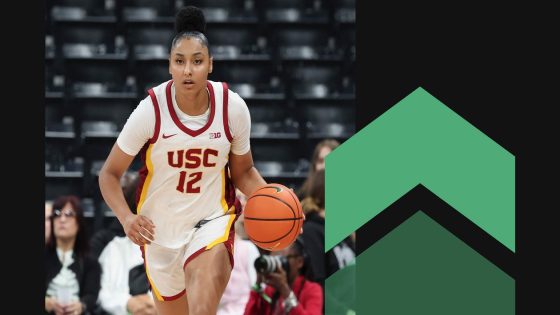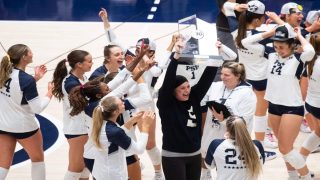With the WNBA Draft lottery on Sunday night, Sabreena Merchant took her talents to Miami … err, New York City … to project the 2025 WNBA Draft. And with her focus there, I was called in to pinch-hit on this week’s power rankings. As an AP voter, I’m sending in my top 25 each week, but now our readers can see exactly what I’m thinking about the upper echelon of women’s hoops (and where it differs from Sabreena’s thoughts).
In my view, there hasn’t been much, if any, change in the top 10 from the preseason, but that should change soon. Not to look too far ahead, but before our next round of power rankings, two games will give us a clear indication of where some elite teams stand and could preview for the Final Four in Tampa. Notre Dame plays USC at 4 p.m. (ET) Saturday on NBC, and South Carolina faces UCLA at 4 p.m. Sunday on FS1.
With that, let’s get to it.
| Rank | Team | Previous rank |
|---|---|---|
|
1
|
 South Carolina South Carolina |
1
|
|
2
|
 UConn UConn |
2
|
|
3
|
 Notre Dame Notre Dame |
3
|
|
4
|
 USC USC |
4
|
|
5
|
 Texas Texas |
6
|
|
6
|
 UCLA UCLA |
5
|
|
7
|
 LSU LSU |
10
|
|
8
|
 Iowa State Iowa State |
8
|
|
9
|
 Oklahoma Oklahoma |
7
|
|
10
|
 Kansas State Kansas State |
9
|
|
11
|
 Maryland Maryland |
13
|
|
12
|
 West Virginia West Virginia |
11
|
|
13
|
 North Carolina North Carolina |
NR
|
|
14
|
 Ole Miss Ole Miss |
18
|
|
15
|
 Ohio State Ohio State |
12
|
|
16
|
 Kentucky Kentucky |
NR
|
|
17
|
 Louisville Louisville |
NR
|
|
18
|
 Duke Duke |
15
|
|
19
|
 NC State NC State |
14
|
|
20
|
 Michigan Michigan |
NR
|
|
21
|
 TCU TCU |
20
|
|
22
|
 Baylor Baylor |
17
|
|
23
|
 Nebraska Nebraska |
NR
|
|
24
|
 Alabama Alabama |
19
|
|
25
|
 Oregon Oregon |
NR
|
Dropped out: Illinois (16), Iowa (21), Michigan State (22), Florida State (23), South Dakota State (24), Harvard (25)
Almost famous: Illinois, Nebraska
South Carolina bucks its slow-start trend
No team looks complete at the start of the season, but worrying trends can show themselves early, and it’s important to take notice and store that thought in the back of your brain. That’s how I felt about South Carolina’s surprisingly slow starts this season. Against Michigan in the season opener, the Gamecocks trailed by three at the end of the first quarter. Against NC State, South Carolina trailed most of the first quarter and never created real separation until midway through the second before going on to win by 14. However, most worrisome was when the Gamecocks didn’t pull away quickly against Coppin State — a team that ranks No. 229 in Her Hoop Stats’ Division I rankings — before breaking away to win by 32.
Sure, a slow start can be overlooked when the result is a victory. But slow starts against top competition aren’t an option. The game is 40 minutes for a reason, and if you only show up for 35 minutes, another elite team will use those five minutes to put its opponent in a deep hole.
Part of the Gamecocks’ slow starts can be explained away by the fact that South Carolina is learning how to play without 6-foot-7 center Kamilla Cardoso, around whom everything orbited last season. Additionally, the Gamecocks have been without a different key player in each of its first three games (Ashlyn Watkins against the Wolverines, Chloe Kitts against NC State, Tessa Johnson against NC State) and the rotational impact is evident.
After playing Coppin State, coach Dawn Staley provided insight into the less-than-stellar starts by some of the Gamecock seniors. “When we have our WNBA-eligible players, sometimes, it happens during the season at some point,” she said. “It hasn’t happened this early. And maybe that’s not what they’re thinking about, but I’m sure they are thinking about it. It makes you press, and it gets you out of your normal routine of focusing on the game — your focus becomes something else. And then the things that you do well aren’t up to par.”
Staley said she wasn’t worried about those players getting their games on track. Against East Carolina on Sunday, the Gamecocks played to their potential from the jump. ECU isn’t a top-25 team, but bucking the trend was a good sign for South Carolina. The Gamecocks shot 44 percent and assisted on seven of eight field goals for a 20-5 first-quarter lead en route to another comfortable victory. But more importantly, their defense looked like it should — dominant — against an overmatched opponent. South Carolina forced 10 turnovers (scoring 16 points off those giveaways), and held ECU to just 20 percent shooting in the first quarter alone.
What’s next for JuJu Watkins?
On Friday night, USC’s JuJu Watkins hit the first — of what we can expect to be many — milestones in her career, crossing the 1,000-point mark. She did it in 38 games, which matches the second-fastest any women’s player has reached 1,000 points (tying Delaware’s Elena Delle Donne and Weber State’s Kathy Miller). Notably, Watkins hit the mark 20 games faster than Cheryl Miller, USC’s all-time leading scorer at 3,018 points, and two games faster than Caitlin Clark, who holds the Division I scoring mark with 3,951 points.
Watkins’ career average is 26.5 points per game. At that rate, the sophomore is on track to break Miller’s program record in 76 games (coming at some point in her senior season), but Clark’s record is likely out of reach unless Watkins averages closer to 30 points per game over the rest of her career.
All of that will be fodder for debate and conversation over the next few seasons, but there’s a more pressing question about Watkins — and the rest of USC’s scoring — right now. How will it look next weekend against Notre Dame?
In all likelihood, Sonia Citron will draw the main defensive assignment on Watkins. With Watkins often initiating the offense, there’s only so much Citron can do to keep the ball out of her hands, but expect the Irish to apply a lot of pressure and to try to force Watkins to settle for longer, contested jumpers. Part of that success will hinge on how successful freshman Kate Koval and transfer Liatu King (assuming she’s cleared in time for the game) contain USC’s bigs in the paint, putting more pressure on Watkins to score but also being there as help when Watkins breaks free for those mid-range jumpers. Fair to say that this will be Watkins’ biggest defensive challenge she has faced this season.
How is Oklahoma different with Raegan Beers?
Raegan Beers, who left Oregon State for Oklahoma’s fast-paced play, was one of the most intriguing offseason transfers. The Sooners use a far different style than the slow, eat-the-shot-clock play she was accustomed to in Corvallis, and curiosity abounded about how Beers would adapt.
On the other side, came the question: How would the Sooners change with Beers? Coach Jennie Baranczyk doesn’t go into the portal to get a player like Beers without the full intention of using her as much as possible. Given Oklahoma’s entry into the SEC, the Sooners needed a physical interior presence to keep up with the other conference teams on the boards, but I kept coming back to the question of how their offense would change in the Beers era.
It’s a party 🤌@RaeganBeers | @OU_Athletics pic.twitter.com/fnjpJSf5lO
— Oklahoma Basketball (@OU_WBBall) November 10, 2024
The caveat here is that we’re only three games in and Oklahoma hasn’t played any SEC-level competition yet (and with only two power conference opponents ahead of league play, the Sooners won’t see many challenges), but there are some early results to study.
Naturally, Oklahoma has been posting up a lot more — nearly twice as much as it did last season (on 17 percent of possessions versus 9.9 percent) — and the Sooners have been far more efficient in scoring on those plays (1.3 points per post-up this season versus .80 points per post-up last season). Doing something more often and being better at it? That’s a no-brainer for an offensive-minded coach, so post-ups expectedly have moved from Oklahoma’s fifth-most frequent type of offensive play to its second-most used.
Beers, who has averaged nearly four offensive rebounds a game, has helped the Sooners’ scoring efficiency on putbacks increase significantly.
Her scoring off post-ups and put-backs is similar to last season’s production. However, her scoring in transition (12.7 percent of her scoring plays this season versus 6.4 percent with Oregon State last season) has nearly doubled.
|
2024-25 season
|
2023-24 season
|
|
|---|---|---|
|
Transition
|
29.2% (1.101 ppp)
|
25.3% (1.018 ppp)
|
|
Post up
|
17% (1.269 ppp)
|
9.9% (0.781 ppp)
|
|
Spot up
|
15.4% (0.766 ppp)
|
19.2% (0.764 ppp)
|
|
Cut
|
11.1% (0.853 ppp)
|
14.2% (1.041 ppp)
|
|
Put backs
|
11.1% (1.206 ppp)
|
7.1% (0.977 ppp)
|
ppp = points per possession
Again, early results here, so don’t take it as gospel quite yet, but it’s something to keep an eye on as the Sooners attempt to vie for the SEC title in their first season in the league.
TCU earns its first ranked-win since 2021 … and a spot in my top 25
When Mark Campbell took over at TCU before last season, he consistently said that TCU — with its reliance on transfer portal players — was a science experiment of sorts. As an injury bug swept through last season’s team, that experiment petered out. But this offseason, Campbell was back at it, adding more high-profile transfers who played deep into March, bringing aboard LSU’s Hailey Van Lith, Oregon State’s Donovyn Hunter and USC’s Taylor Bigby.
On Sunday, TCU took down NC State (No. 13 AP poll, No. 14 The Athletic), marking the program’s first win against a ranked opponent since 2021. NC State had no answer for Sedona Prince (31 points, 16 rebounds), making the Wolfpack’s transition to a post-River Baldwin/Mimi Collins era particularly painful. NC State also didn’t have much of a response for Van Lith, who finished with 18 points and 10 assists.
TCU’s roster has plenty of talent (especially well-known talent), but what makes the Horned Frogs even more interesting is that they’re the oldest team in college hoops with eight fifth-year seniors (or older), including five players who are two-time transfers:
• Sedona Prince (Texas > Oregon > TCU)
• Hailey Van Lith (Louisville > LSU > TCU)
• Taylor Bigby (Oregon > USC > TCU)
• Maddie Scherr (Oregon > Kentucky > TCU)
• Deasia Merrill (Kentucky > Georgia State > TCU)
That level of seniority can be a huge advantage for several reasons. The experience factor (they’ve seen it all, they’re not fazed by anything) comes into play, but there’s also a greater sense of urgency. They’ve got one season left, and they’ve tried to make it work at other schools, but this is their last shot to pull it all together. That can drive players to the next level, and it can push teams to their potential.
The science experiment at TCU? I’m not saying they’ve proven anything decisively quite yet, but it’s worth monitoring what the Horned Frogs can do in the lab this season with the vets on their roster.
(Photo of JuJu Watkins: Catherine Steenkeste / Getty Images)





